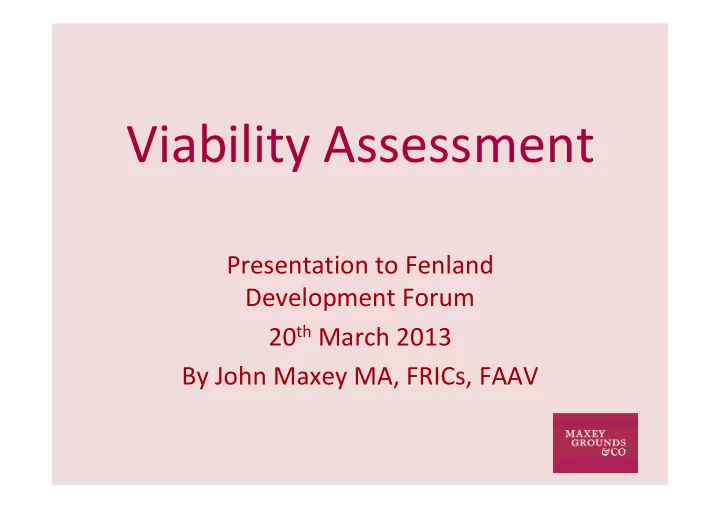

Viability Assessment Presentation to Fenland Development Forum 20 th March 2013 By John Maxey MA, FRICs, FAAV
What is Viability Assessment “An objective financial viability test of the ability of a development project to meet its costs including the cost of planning obligations, whilst ensuring an appropriate site value for the landowner and a market risk adjusted return to the developer in delivering that project.” RICS Guidance Note – Financial Viability in Planning
Policy Context National Planning Policy Framework context: “….To ensure viability, the costs of any requirements likely to be applied to development, such as requirements for affordable housing, standards, infrastructure contributions or other requirements should, when taking account of the normal cost of development and mitigation, provide competitive returns to a willing land owner and willing developer to enable the development to be deliverable.” “….In order to be appropriate, the cumulative impact of these standards and policies should not put implementation of the plan at serious risk, and should facilitate development throughout the economic cycle.” (NPPF Paras 173 ‐ 174)
When is Viability Testing used The main purposes of viability testing are: • assessing the nature and level of planning obligation contributions/ requirements; • establishing the level of affordable housing; • identifying the split between affordable housing tenures; • establishing off ‐ site affordable housing levels • assessing contributions in lieu payments for affordable housing; • the timing of planning obligations contributions and affordable housing delivery; • applications incorporating enabling development; • assessing the bulk, scale and massing (and specification relative to cost and value) of a proposed scheme; • reviewing land uses formulating planning policy through local development plans; and • • consideration by local authorities when drafting and viability testing CIL charging schedules. Assessing / Negotiating S106 agreements •
Viability Testing - Guidance THERE IS NO STATUTORY GUIDANCE NPPF says: ‘ Evidence supporting the assessment should be proportionate, using only appropriate available evidence’. The CIL guidance says ‘ The legislation (section 212 (4) (b)) requires a charging authority to use 'appropriate available evidence' to inform their draft charging schedule. It is recognised that the available data is unlikely to be fully comprehensive or exhaustive. Charging authorities need to demonstrate that their proposed CIL rate or rates are informed by ‘appropriate available’ evidence and consistent with that evidence across their area as a whole’ .
Standard Viability Test Gross Development Value (The combined value of the complete development) LESS Cost of creating the asset, including PROFIT (Construction + fees + finance charges) = RESIDUAL VALUE Comparing Residual Value v Existing / Alternative Use Value indicates if a site is viable Deducting Existing / Alternative Use value will give a positive or negative viability figure
Cumulative impact of policy and planning obligations
Viability Appraisal Methodology • Various Viability Testing Tools • FDC prefer the HCA DAT • Other programmes provide equivalent calculations • All are forms of spreadsheet using discounted cash ‐ flow methods to calculate residual land value or surplus/deficit figure
Data Inputs • Proposed Property Types, Size • Proposed Property Tenure • Values – capital and rental • Build Costs – properties, externals, infrastructure • Other costs – management of affordable element, S106, architects and agents • Profit level/return to developer • Site Value / Competitive Return to Landowner
Supporting Evidence • Site Value / Competitive Return • Values – market evidence – transactions or Land Registry • Costs – specific quotations, BCIS or other benchmark levels • Affordable Housing Contributions – RP or Local Authority sources • Other inputs – supporting documentation eg S106 requirements from Planning Department
Local Plan Testing National Planning Policy Framework context: “….To ensure viability, the costs of any requirements likely to be applied to development, such as requirements for affordable housing, standards, infrastructure contributions or other requirements should, when taking account of the normal cost of development and mitigation, provide competitive returns to a willing land owner and willing developer to enable the development to be deliverable.” “….In order to be appropriate, the cumulative impact of these standards and policies should not put implementation of the plan at serious risk, and should facilitate development throughout the economic cycle.” (NPPF Paras 173 ‐ 174)
Viability and FDC Core Strategy Affordable Housing Viability Study Jan 2010 – not updated yet Joint study ‐ Four Local Authorities (FDC, EC, FH, St E) based upon information to 2009. “The results can be described as very mixed. Those produced by the appraisals at lower value levels are weak in viability terms,...” (para 4.1.11) Appendix 2 Table 1 – 0 residual land value for all types of site at value point 1 (most of Fenland) and all but the smallest sites at value point 2 (the southern part of the district) at 0% affordable housing Market difficulties then perceived as short term, hence a higher target was set Since then values have continued to fall and costs rise, adversely affecting viability further
Planning Applications ‐ Post Submission Process For Planning Applications and specifically FDC • Quote obtained for cost of independent assessment of submitted appraisal – applicant required to bear this cost. • Draft Report produced – usually shared with applicant and his assessor if queries raised. • Housing/Planning Officer’s recomendation on Affordable Housing and S106 requirements
Conclusions • Viability a real issue and challenge in Fenland • Viability is a material consideration in Applications • Can be used to challenge Affordable Housing and other S106 requirements for specific applications • Does impose at present additional costs on applicants • Methodology requires appreciation of costs and values applicable to the market and evidence of inputs utilised • Required to be used to test the soundness of Proposed Core Strategy Policies
Any Questions ?
Recommend
More recommend